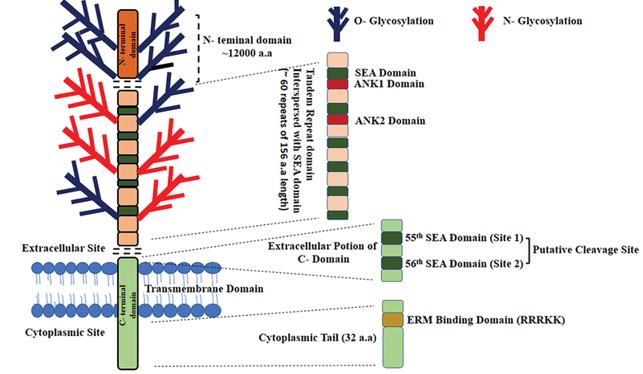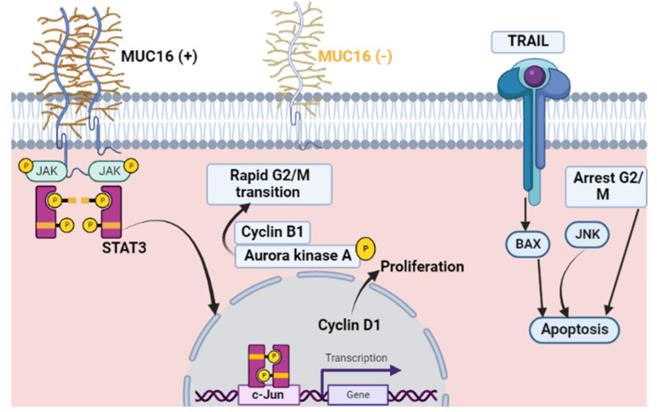Introduction of CD3
CD3, a crucial cell surface complex, comprises four distinct subunits—γ, δ, ε, and ζ chains. These subunits are intricately associated with the T cell antigen receptor (TCR), playing pivotal roles in TCR expression and signal transduction. Predominantly expressed on T cells, CD3 is indispensable for T cell activation and proliferation. Notably, CD3 serves as a prime target for immunotherapy. Bispecific antibodies (bsAbs) that bind to both CD3 and a tumor-associated antigen facilitate T cell redirection towards tumor cells, thereby unleashing potent cytotoxic effects.
Introduction of MUC16
MUC16, an expansive glycoprotein, finds primary expression on the epithelial cells of the ocular surface, respiratory tract, and female reproductive tract. Functionally, it forms a lubricating barrier, thwarting the entry of foreign bodies and pathogens. The extracellular segment of MUC16 can undergo cleavage to produce CA125, a diagnostic marker for ovarian cancer. Overexpression of MUC16 is evident in various solid tumors, particularly ovarian cancer, correlating with tumor invasion, metastasis, and drug resistance. MUC16 emerges as a promising therapeutic target. BsAbs binding to both CD3 and MUC16 hold the potential to elicit a T cell-mediated immune response against MUC16-positive tumor cells.
 Fig.1 Schematic Representation of MUC16 Structure (Aithal A, 2018)
Fig.1 Schematic Representation of MUC16 Structure (Aithal A, 2018)
Signaling Pathways Involved in Bispecific Antibodies Targeting CD3 and MUC16
The TCR/CD3 complex constitutes the primary structure enabling T cells to identify antigens and initiate activation signals. Upon TCR recognition of an antigen peptide presented by the major histocompatibility complex (MHC), tyrosine kinases (e.g., Lck and ZAP-70) phosphorylate the immunoreceptor tyrosine-based activation motifs (ITAMs) in CD3 subunits. These phosphorylated ITAMs function as signal transduction molecules, initiating a cascade of downstream effectors, including the Ras-MAPK pathway, PI3K-Akt pathway, NF-κB pathway, and NFAT pathway. These pathways collectively regulate T cell processes such as proliferation, differentiation, effector function, and memory function. MUC16 contributes to tumor development through diverse mechanisms. Firstly, MUC16 shields tumor cells from immune attacks by inhibiting natural killer cell activity, impairing antigen-presenting cell function, and disrupting T cell adhesion and migration. Secondly, MUC16 influences tumor cell interactions with the matrix and other cells, promoting invasion and metastasis. For instance, MUC16 binds to cell adhesion molecules (e.g., E-cadherin, ICAM-1, and VCAM-1), altering intercellular junctions. Additionally, MUC16 binds to cell surface receptors (e.g., EGFR, ErbB2, and Mesothelin), activating related signaling pathways. Furthermore, MUC16 modulates factors in the tumor microenvironment, such as growth factors, cytokines, and chemokines, impacting tumor growth and angiogenesis. Bispecific antibodies targeting CD3 and MUC16 operate by forming an immune cell-tumor cell (ICT) complex. This is achieved through simultaneous binding to CD3 on T cells and MUC16 on tumor cells, leading to T cell-dependent cellular cytotoxicity (TDCC). Remarkably, this mechanism doesn't require MHC restriction or co-stimulatory signals and remains unaffected by immune checkpoint molecules. These bsAbs exhibit dual effects on signaling pathways. On one hand, they activate downstream signaling pathways of the TCR/CD3 complex, prompting T cells to release effectors (e.g., cytokines, chemokines, and toxins) and inducing T cell polarization into highly efficient subtypes (e.g., Th1 or CTL). On the other hand, they interfere with signaling pathways associated with MUC16, diminishing tumor cell survival, proliferation, and migration while enhancing tumor cell sensitivity to immune attacks.
 Fig.2 MUC16 Expression in Cancer (Saad HM, 2022)
Fig.2 MUC16 Expression in Cancer (Saad HM, 2022)
Clinical Status of Bispecific Antibodies Targeting CD3 and MUC16
As of now, no bispecific antibody (bsAb) targeting CD3 and MUC16 has received approval. Nevertheless, several bsAbs directed at CD3 and MUC16 are actively undergoing clinical investigation, primarily focusing on the treatment of ovarian cancer and other MUC16-positive solid tumors. Two noteworthy candidates in this realm are REGN4018 and LBL-033, both designed as bispecific antibodies targeting MUC16 and CD3. REGN4018, crafted by Regeneron Pharmaceuticals, a leading biotechnology company based in the United States, is presently advancing through phase 1/2 clinical trials. These trials specifically target recurrent ovarian cancer and other advanced solid tumors. Encouragingly, REGN4018 has exhibited promising anti-tumor activity and safety in both preclinical studies and early clinical data. LBL-033, developed by Leads Biolabs, a distinguished biotechnology company headquartered in China, is also in the midst of phase 1/2 clinical trials targeting ovarian cancer and other malignant tumors. What sets LBL-033 apart is its unique bispecific antibody molecule design, which enhances drug aggregation in MUC16-overexpressing tumor cells while minimizing non-specific activation of CD3. In animal models, LBL-033 has demonstrated potent anti-tumor efficacy and favorable pharmacokinetic properties.
Table 1. Important Information about REGN4018 and LBL-033
|
Name
|
Developer
|
Clinical Phase
|
Indication
|
Design
|
Efficacy
|
Safety
|
|
REGN4018
|
Regeneron Pharmaceuticals
|
I/II
|
Recurrent ovarian cancer
|
2:1 format with two arms targeting MUC16 and one arm targeting CD3
|
14% overall response rate (ORR) in 42 patients with recurrent ovarian cancer across dose levels; 21% ORR in patients without visceral metastases; 31% ORR in patients with high MUC16-expressing tumors
|
Most common adverse events (AEs) were cytokine release syndrome (74%, all ≤grade 2), pain (87%) and anemia (51%)
|
|
LBL-033
|
Leads Biolabs
|
I/II
|
Ovarian cancer and other malignant tumors
|
2:1 format with two arms targeting MUC16 membrane-proximal domain and one arm targeting CD3
|
Not reported
|
Favorable pharmacokinetic properties with a good safety profile in cynomolgus monkeys
|
References
-
Middelburg J, et al. Overcoming Challenges for CD3-Bispecific Antibody Therapy in Solid Tumors. Cancers (Basel). 2021 Jan 14;13(2):287.
-
Singh A, et al. Overcoming the challenges associated with CD3+ T-cell redirection in cancer. Br J Cancer. 2021 Mar;124(6):1037-1048.
-
Kaplon H, et al. Antibodies to watch in 2022. MAbs. 2022 Jan-Dec;14(1):2014296.
-
Aithal A, et al. MUC16 as a novel target for cancer therapy. Expert Opin Ther Targets. 2018 Aug;22(8):675-686.
-
Wang Q, et al. Oncolytic adenovirus with MUC16-BiTE shows enhanced antitumor immune response by reversing the tumor microenvironment in PDX model of ovarian cancer. Oncoimmunology. 2022 Jul 1;11(1):2096362.
-
Saad HM, et al. The Potential Role of MUC16 (CA125) Biomarker in Lung Cancer: A Magic Biomarker but with Adversity. Diagnostics (Basel). 2022 Nov 29;12(12):2985.
-
Sun J, et al. Abstract 2965: LBL-033, a novel bispecific antibody targeting MUC16 and CD3, for the treatment of tumors over-expressing MUC16. Cancer Res. 2023 Apr 1;83(7_Supplement):2965.
-
Wang Q, et al. Bispecific Antibodies in Lung Cancer: A State-of-the-Art Review. Pharmaceuticals (Basel). 2021 Oct 14;16(10):1461.
-
Moore PA, et al. A Bispecific Antibody for MUC16 and CD3 Has Preclinical Antitumor Activity in Ovarian Cancer. Cancer Discov. 2019 Aug;9(8):994-1005.
-
Li J, et al Overcoming Challenges for CD3-Bispecific Antibody Therapy in Solid Tumors. Cancers (Basel). 2021 Jan 14;13(2):287.
Our products and services are for research use only, and not for use in diagnostic or therapeutic procedures.
Welcome! For price inquiries, we will get back to you as soon as possible.
To order, please email
INQUIRY


 Fig.1 Schematic Representation of MUC16 Structure (Aithal A, 2018)
Fig.1 Schematic Representation of MUC16 Structure (Aithal A, 2018)
 Fig.2 MUC16 Expression in Cancer (Saad HM, 2022)
Fig.2 MUC16 Expression in Cancer (Saad HM, 2022)






